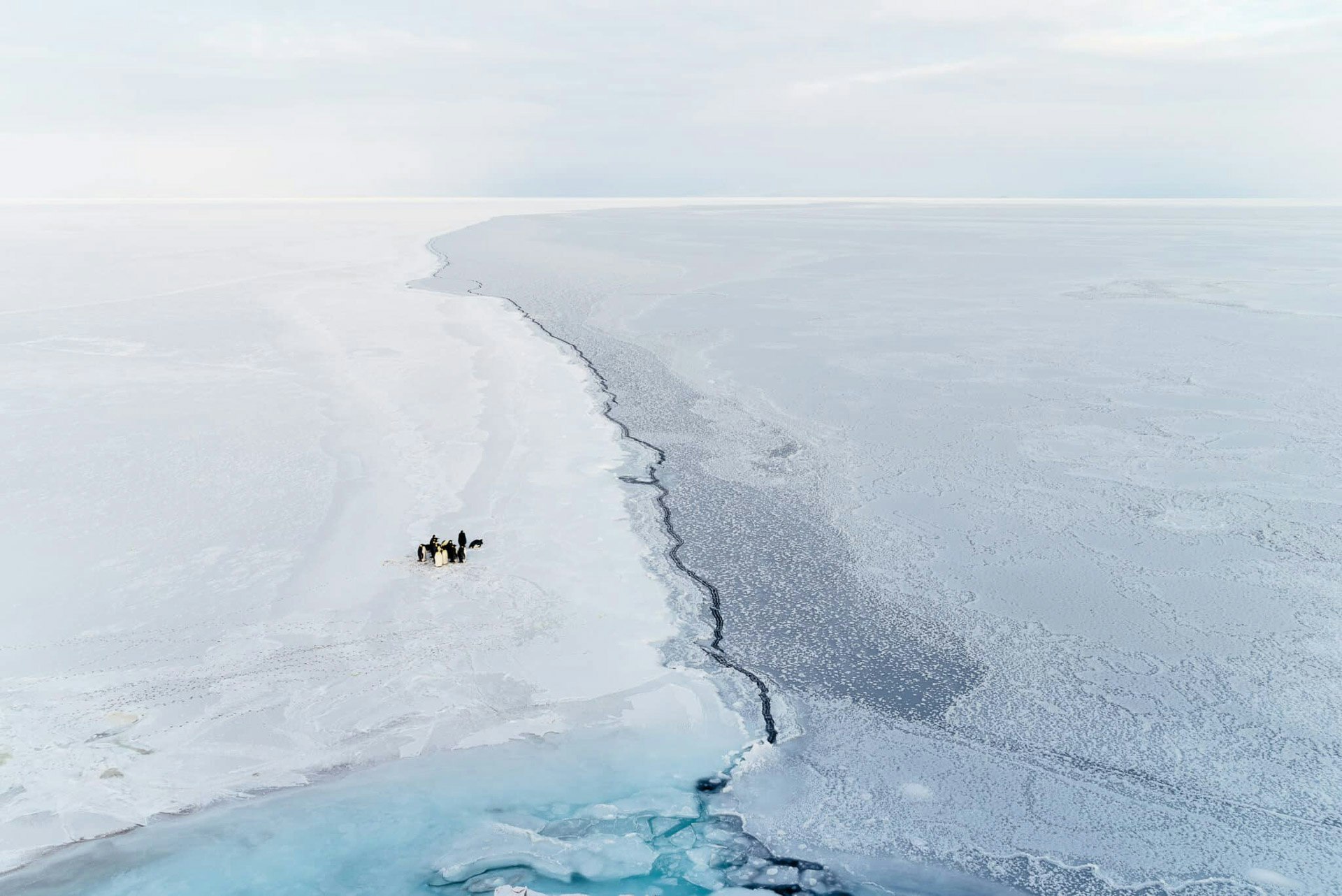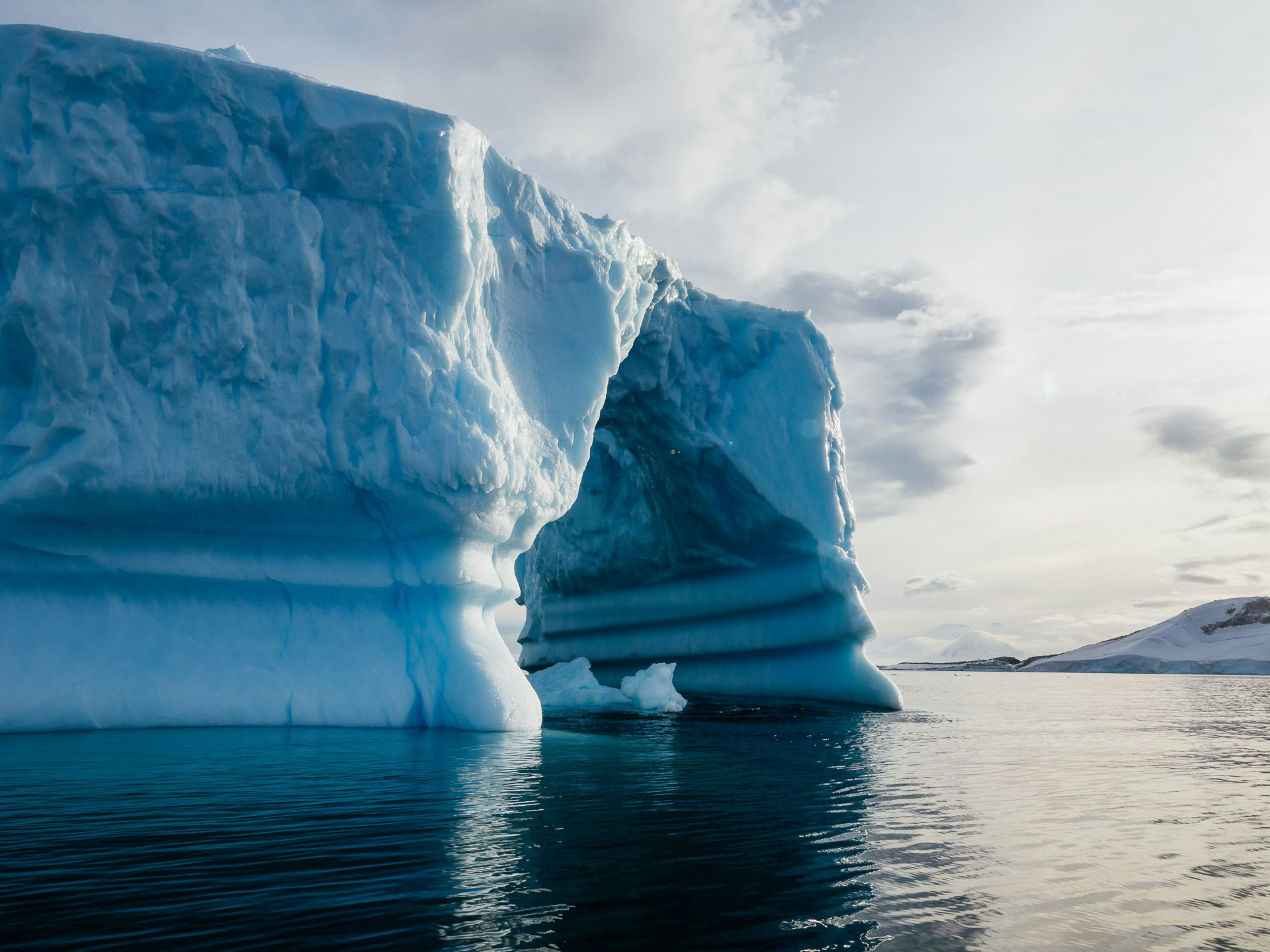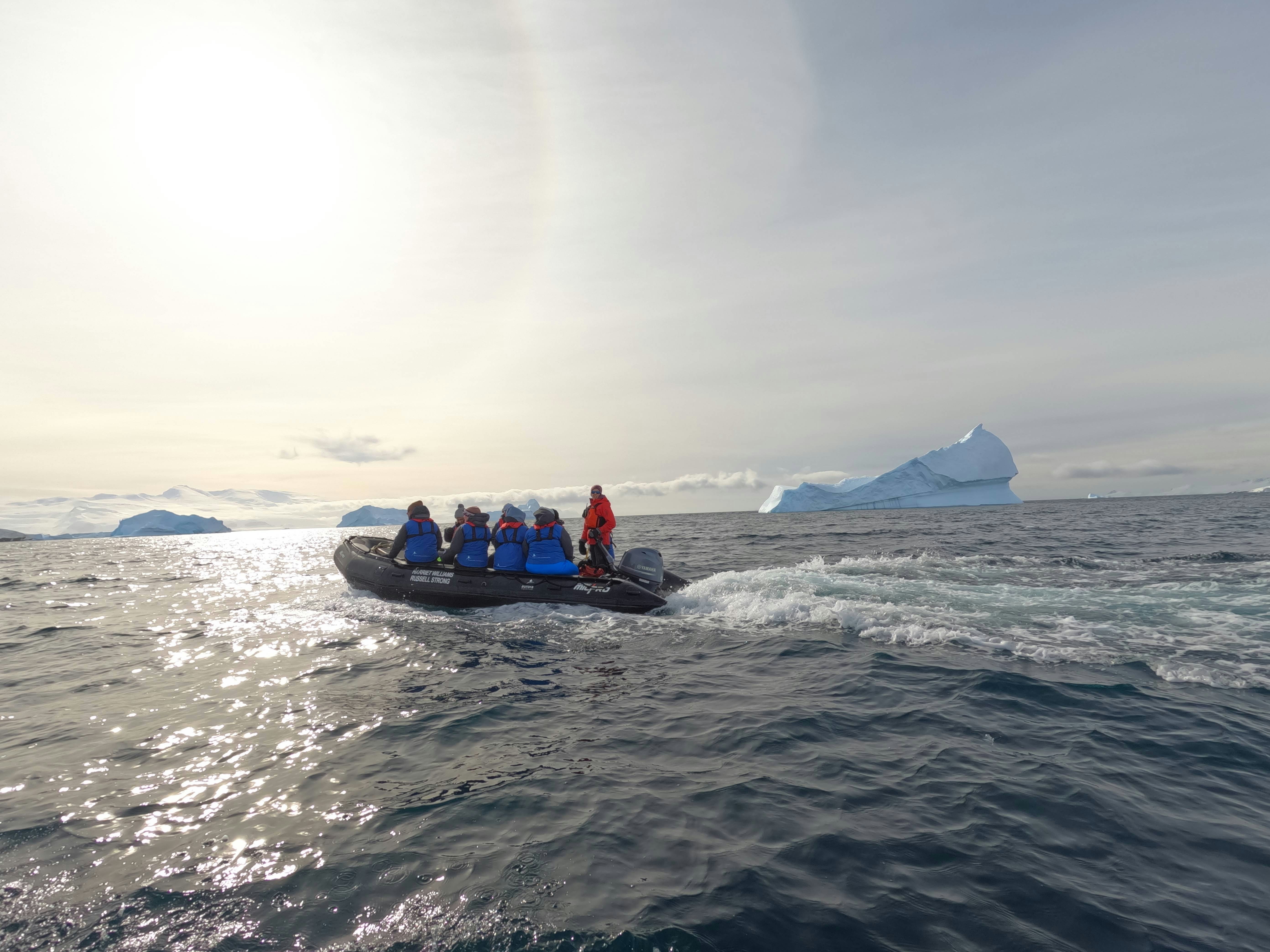Small Ships, Big Adventures in Antarctica
Antarctica is a place where you can disconnect from the noise of the outside world, immersed in the beauty of breathtaking backdrops as you embark on an adventure of spectacular icebergs, iconic the ice, wildlife and the ever-changing landscapes. A place where people become present with each other, forging connections that last a lifetime.
Set sail to Antarctica with Aurora Expeditions’ responsible small ship adventures, with sailings available in 2025, 2026 and 2027.
With over 33 years’ experience, our Antarctica Cruises offer unparalleled adventure. Book the adventure of a lifetime today and secure your preferred stateroom, plus enjoy savings of up to 25% off*!
Antarctica Cruises 2025/2026
Spirit of Antarctica
Epic Antarctica: Crossing the 7th Continent
Falklands, South Georgia & Antarctic Peninsula
Across the Antarctic Circle
Destinations in the Antarctic
Whether you want to see the steep-sided mountains of the Antarctic Peninsula, the enormous king penguin colonies of South Georgia, venture as far south as the Antarctic Circle or explore the fabled Ross Sea, we have an expedition for every adventurer.
Antarctic Peninsula
An Antarctic Peninsula expedition is the classic way to experience the white continent and the first taste of Antarctica for most expeditioners.
South Georgia
Experience the greatest wildlife show on the planet on your South Georgia expedition, with thousands of king penguins, seals and seabirds. Zodiac-cruise past towering glaciers and jaw-dropping icebergs to sandy beaches dotted with relics from South Georgia’s dark whaling past.
Antarctic Circle
The Antarctic Circle offers a glimpse of an elemental wilderness that is rarely visited – a world that’s colder, rawer and wilder.
Falkland~Malvinas
Islas Malvinas to the Argentines and the Falkland Islands to the British, the Falklands~Malvinas are teeming with dramatic military history alongside wildlife, making it a popular stop for travellers on their way to Antarctica
Weddell Sea
Visit part of Antarctica that few get to experience on a true expedition that pushes below the Antarctic Circle to the eastern side of the Antarctic Peninsula. Embrace the spirit of exploration as you attempt to forge a path through the ice-choked Weddell Sea.
Ross Sea & East Antarctica
Embark on an odyssey that traces the footsteps of legends like Scott, Shackleton and Mawson, as you navigate through the icy realms of the Ross Sea, Commonwealth Bay and the enigmatic coast of East Antarctica on a small, purpose-built expedition ship.
Australia & New Zealand Subantarctic Islands
Welcome to Aurora Expeditions’ newest frontier: Australia and the Subantarctic Islands of New Zealand. Discover a realm where towering cliffs plunge into icy waters, where colonies of penguins thrive, and where rare flora blankets the rugged terrain.
Best time to go
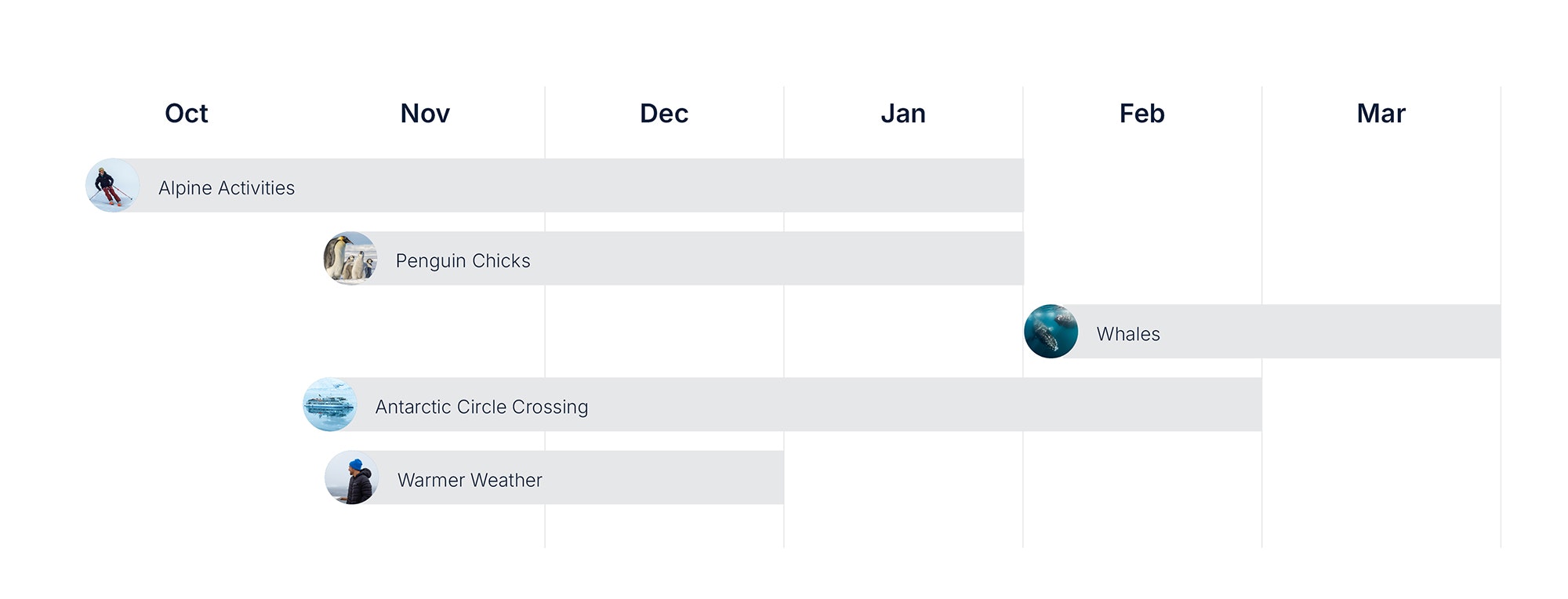
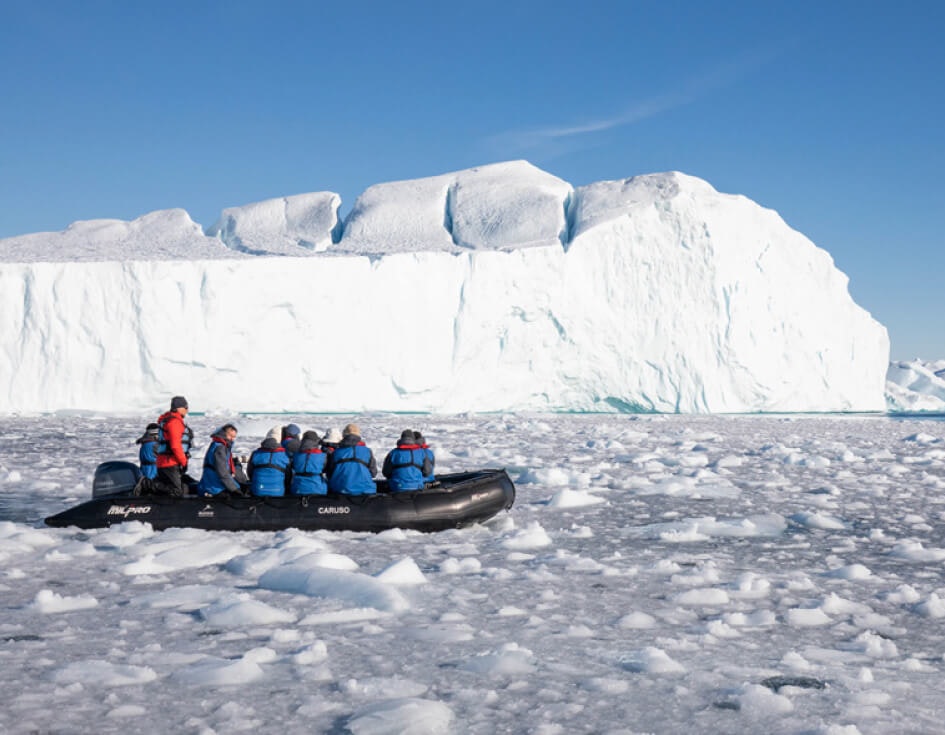
Frequently Asked Questions about cruising to Antarctica
Antarctica is the southernmost continent on Earth. The South Geographic Pole is in Antarctica, and most of the continent lies within the Antarctic Circle, at 66.5 degrees south of the Equator.
Antarctica is so far south that most of the continent receives 24 hours of daylight during summer, and 24 hours of darkness during winter.
Antarctica lies to the south of Australia, New Zealand, South Africa and South America, and is surrounded by the Southern Ocean (also known as the Antarctic Ocean). Most visitors access Antarctica via ship or aircraft from an Antarctic ‘gateway city’. The five official Antarctic gateway cities are Ushuaia (Argentina), Hobart (Australia), Punta Arenas (Chile), Christchurch (New Zealand), and Cape Town (South Africa).
The name ‘Antarctica’ comes from ‘Antarktos’, meaning ‘opposite the Arctic’. Antarctica and the Arctic are indeed opposites in many ways, and they lie at the polar extremes of the globe: the Arctic to the north and Antarctica to the south.
Antarctica is the coldest continent on Earth. The average temperature throughout the year is about -57°C, with the minimum temperature being -130°F (-90°C) during the winter season.
During the summer months, when we visit, the temperature can range from 28°F (-2°C) to 46°F (8°C). In summer, big storms are rare, but if one comes through the temperature could drop to 17°F (-8°C ).
Antarctica is home to a hardy community of wonderful wildlife, which has adapted to the cold, windy and icy Antarctic environment.
There are four species of penguins in Antarctica. They are the emperor, Adélie, gentoo and chinstrap. The emperor and Adélie penguins are found only in Antarctica.
There are six species of Antarctic seals: Ross seals, Weddell seals, crabeater seals, leopard seals, southern fur seals and southern elephant seals. They all live in the ocean surrounding Antarctica, hauling out on ice or land to rest and pup.
Many whales visit Antarctic waters during the summer feeding season between late October and early April. The whales that commonly visit Antarctic waters include humpback whales, killer whales, minke whales, fin whales, sei whales and even the enormous blue whale!
In addition to these charismatic creatures we see on the ocean’s surface, the Antarctic ocean is filled with a rich variety of sea life, from single-celled algae, which form the foundation of the Antarctic food web, to krill, a tiny crustacean which is a keystone species in the Antarctic ecosystem, providing sustenance for seals, whales, penguins and many other seabirds.
Most animals that thrive in Antarctica are marine animals. This means that they rely on the ocean and marine ecosystems to survive and thrive. However, there are a few Antarctic animals that live entirely on land. These include the microscopic springtails, nematodes and tardigrades, which live amongst moss and lichen in areas which are not permanently snow-covered.
How long is an Antarctica cruise?
Antarctica cruises typically last between 9 to 34 days, with most cruises ranging from 12 to 21 days. The duration depends on factors such as departure location and itinerary. Shorter trips focus on highlights, while longer voyages explore more remote regions.
You can reach Antarctica from the southern tip of South America or from 2025, start your trip from Hobart, Australia or Dunedin, New Zealand. Two popular departure points for Antarctica cruises are Ushuaia, Argentina, and Punta Arenas, Chile, both located in the Patagonian region and are among the southernmost towns on Earth.
Antarctica cruises commencing in Ushuaia typically involve crossing the Drake Passage to reach the Antarctic Peninsula or voyaging to the Subantarctic Islands of the Falklands or South Georgia before continuing onward to Antarctica.
Alternatively, passengers departing from Punta Arenas can enjoy a unique experience by flying to Antarctica, specifically King George Island, via a charter flight arranged exclusively for their expedition.
The cost of an Antarctica cruise can vary significantly, influenced by factors such as voyage duration, stateroom type, and the chosen itinerary.
When considering an Antarctica cruise with Aurora Expeditions, you can expect prices to start from USD$13,195 per person when sharing a twin Aurora Stateroom. However, there are also early bird discounts available.
Are there any health considerations for travellers visiting Antarctica?
Travellers planning a visit to the Antarctic Peninsula should consult their healthcare provider for guidance on necessary vaccinations and health precautions.
Good health and physical preparedness are crucial for the demands of the expedition.
Aurora Expeditions requires passengers to submit a signed medical form from their healthcare provider during the booking process.
Travellers must adhere to environmental protection guidelines and practice responsible tourism to safeguard Antarctica’s delicate ecosystem throughout their cruise.
Although you cannot swim in Antarctica, most of our voyages stop for a ‘Polar Plunge’, where all willing passengers can take the ultimate dip into the icy Antarctic waters. You do have the option to take up our Polar Snorkelling activity, or experienced scuba divers have the option to dive, on selected voyages. Additional charges may apply.
Children are more than welcome on our Antarctica cruises. However, we recommend that they are at least 8 years old and must travel with their legal guardian. Children pay the same rate as an adult traveller.
Shipboard attire leans toward the informal and casual side, you’ll find jeans, jumpers, and long-sleeved shirts comfortable indoors. It’s wise to have your jacket within reach for impromptu wildlife encounters.
While there’s no need for formal clothing, some travellers like to dress up for the captain’s welcome and farewell drinks.
Each passenger on our Antarctic cruises will receive an expedition jacket. Though, you should pack suitable cold and wet weather gear for onshore landings during your Antarctica cruise.
To help you prepare, consult our suggested packing list, which outlines the recommended types of layers and materials for an Antarctica cruise.







